Until 1879, when the Central station, opened there were three widely spaced passenger termini in Sunderland. The route from Gateshead (and, later, Newcastle) had its terminus at Monkwearmouth, to the north of the River Wear; trains from Durham via Leamside terminated at Fawcett Street, south of the Wear and close to the town centre; and finally trains from Seaham and the Hartlepools used a third terminus at Hendon, south of the river and close to the docks.
 The decision was taken by the North Eastern Railway (NER) to concentrate all of the traffic on one station conveniently placed to serve the town (now city) centre, and the contract was let in November 1874 for the expensive project. South of Monkwearmouth station the new line crossed the River Wear then ran through a cut-and-cover tunnel to the somewhat cramped Central station within a cutting. On its opening in August 1879 the Fawcett Street and Hendon termini closed. However the former terminus at Monkwearmouth was retained, an opulent classically-styled station, which in Biddle’s (1973) words, ‘became a mere suburban station, stranded like some handsome ship in a breaker’s yard’. The decision was taken by the North Eastern Railway (NER) to concentrate all of the traffic on one station conveniently placed to serve the town (now city) centre, and the contract was let in November 1874 for the expensive project. South of Monkwearmouth station the new line crossed the River Wear then ran through a cut-and-cover tunnel to the somewhat cramped Central station within a cutting. On its opening in August 1879 the Fawcett Street and Hendon termini closed. However the former terminus at Monkwearmouth was retained, an opulent classically-styled station, which in Biddle’s (1973) words, ‘became a mere suburban station, stranded like some handsome ship in a breaker’s yard’.
In the late nineteenth century Sunderland was a railway hub of some importance. Routes radiated to South Shields, Newcastle, Durham (via Leamside), Durham Elvet (via Murton), Stockton (via Wellfield) and Seaham Harbour; in 1905 the direct coastal route to West Hartlepool and Middlesbrough was added.
Fawcett (2005) includes a detailed description of Sunderland Central station. It consisted of two island platforms beneath a 95ft-span arched roof springing from brick retaining walls. The constricted site limited the width of the platforms, so all of the passenger facilities, including waiting rooms, were to be found surrounding a large hall carried above the railway on arches. The original design for the station building disappointed Sunderland Town Council, and NER Architect William Bell was permitted a more generous budget to provide something more impressive. The result was the provision of a lofty two-storey range concealing the end of the hall, and a French Gothic clock tower, ‘garnished with tourelles at the clock stage and rising 118ft to the tip of the spire’. The Sunderland Daily Echo considered the station ‘a most attractive and, in many respects, imposing addition to the town’.
 In Fawcett’s opinion Sunderland station was an accomplished design. However he notes that, for various reasons, the station had shortcomings. Passenger access to the platforms, booking facilities and parcels facilities proved inadequate, as did the ventilation of the platforms – when all trains were steam-hauled. The NER, as early as 1883, improved access by creating a second entrance onto a spacious bridge concourse within the trainshed, equipped with a wooden booking office and gently sloping ramps to the platforms. In 1895-7 further changes were made, described by Fawcett (2007). In Fawcett’s opinion Sunderland station was an accomplished design. However he notes that, for various reasons, the station had shortcomings. Passenger access to the platforms, booking facilities and parcels facilities proved inadequate, as did the ventilation of the platforms – when all trains were steam-hauled. The NER, as early as 1883, improved access by creating a second entrance onto a spacious bridge concourse within the trainshed, equipped with a wooden booking office and gently sloping ramps to the platforms. In 1895-7 further changes were made, described by Fawcett (2007).
The London & North Eastern Railway absorbed all of the NER lines and stations in 1923. In LNER ownership the glass was removed from the trainshed at an early stage of World War 2 as an air raid precaution. On 6 September 1940 the central part of the trainshed was hit in a bombing raid, and in another raid the parcels office was destroyed; the main buildings were not damaged. In 1944 the LNER decided to replace the damaged section of the trainshed with glass-and-steel verandahs, and in 1953 British Railways’ North Eastern Region - within whose area Sunderland had been since January 1948 – removed the rest of the trainshed and extended the earlier verandahs. The station did not receive totem signage, but instead the electric lights under the platform roofing had brick-shaped diffusers carrying the station name: Sunderland – not ‘Central’, the suffix rarely being used as this was the only principal station in the town. Some modest rebuilding of the south booking hall also took place in 1953. During WW2 Sunderland Corporation had held discussions with the LNER about the complete reconstruction of the station, but this was not accomplished until 1966 when BR(NE) demolished the surface buildings, including the distinctive clock tower.
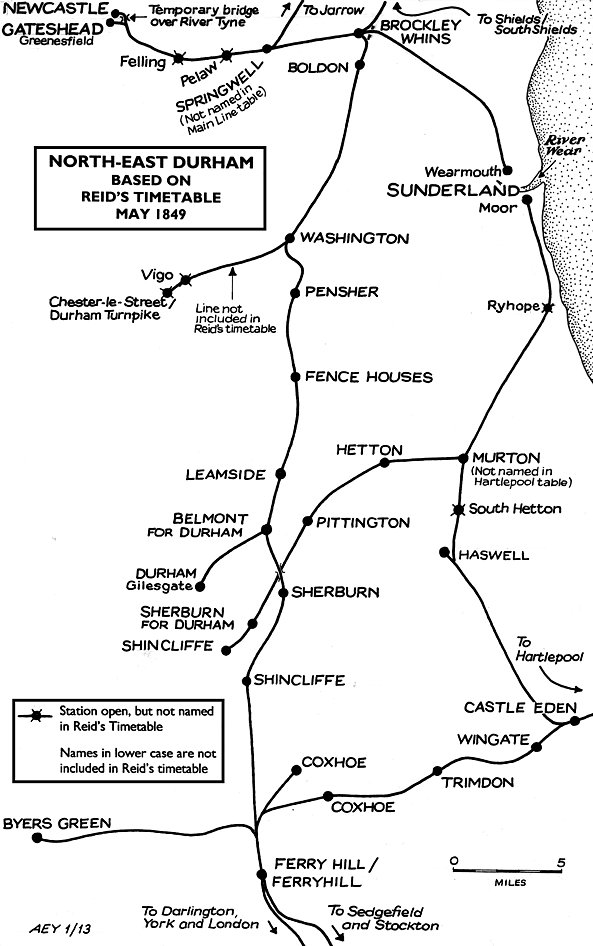
The 1965-6 reconstruction gave Sunderland a dispiritingly bland entrance building, reflecting the new British Rail ‘Corporate Identity’ philosophy, and what Fawcett accurately describes as a ‘joyless dungeon’ at platform level, artificially lit beneath a steel and concrete deck with shops at ground level. Remarkably for a town of its size (over 200,000) by 1965 Sunderland had only one railway route passing through it - Newcastle to Middlebrough – and all passenger trains could be handled on the two faces of the eastern island platform. The western platform was retained for parcels traffic. The new entrance building on the south side of the station opened on 4 November 1965.
In 2002 Metro services from Pelaw were extended through Sunderland and onward to South Hylton, largely on the alignment of the former line from Leamside and Penshaw. The unique situation was in place for both light and heavy rail to share the same tracks and call at the same platforms; Northern Rail trains between Newcastle and Middlesbrough use the northern end of the island platforms’ two faces, while Metro trains use the southern end. Some ‘restoration’ of the station building was attempted, but at platform level the station remained one of the most unlovely in the country – rivalled by Birmingham New Street, similarly deprived of daylight.
 Nexus, the operator of the Tyne and Wear Metro, announced a £7 million refurbishment platform areas at Sunderland in 2006 to be funded by the Department for Transport in a scheme in which the money ‘saved’ by reducing a subsidised local Northern Trains service in favour of Metro was converted into a lump sum for capital investment. Nexus does not own or manage the station - it is owned by Network Rail and managed by Northern - but wanted to invest as the major operator. Refurbishment began in January 2008 and was completed in July 2010. Nexus appointed Sadler Brown Architecture to develop the design, led by Arup Consulting Engineers which incorporated the work of three artists, Jason Bruges Studio, Julian Germain and Morag Morrison. Nexus, the operator of the Tyne and Wear Metro, announced a £7 million refurbishment platform areas at Sunderland in 2006 to be funded by the Department for Transport in a scheme in which the money ‘saved’ by reducing a subsidised local Northern Trains service in favour of Metro was converted into a lump sum for capital investment. Nexus does not own or manage the station - it is owned by Network Rail and managed by Northern - but wanted to invest as the major operator. Refurbishment began in January 2008 and was completed in July 2010. Nexus appointed Sadler Brown Architecture to develop the design, led by Arup Consulting Engineers which incorporated the work of three artists, Jason Bruges Studio, Julian Germain and Morag Morrison.
Jason Bruges Studio has created a 460ft light wall with individual LED units containing an animated display. Julian Germain is providing a sequence of 41 photographs of everyday items ‘lost’ in a Metro environment, while Morag Morrison is designing coloured glass wall panels for buildings along the island platform.The project also saw an entirely new floor, ceilings and lighting, substantial improvements to existing walls and significant reorganisation of buildings and waiting areas on the platforms.
ADDITIONAL SOURCE
Wikipedia -2006-10 redevelopment of the station
BRIEF HISTORY OF THE SUNDERLAND TO DURHAM (AND BISHOP AUCKLAND) VIA LEAMSIDE LINE
Despite its name the Durham & Sunderland Railway (D&S) – not via Leamside – never did reach Durham City. Its route from South Dock, Sunderland, extended through Murton to Haswell (where the Hartlepool Dock & Railway Company already had a terminus) which opened in 1836, with a branch from Murton through Hetton, Pittington and Sherburn House to Shincliffe, two miles south-east of the Durham City centre, which opened in 1839. The North Eastern Railway eventually diverted the line from Shincliffe to terminate in Durham at Elvet station in 1893.
 In an Act of 27 July 1846 the Newcastle & Darlington Junction Railway (see ‘Old Main Line’ history) was authorised to build a line from Pensher (later known as Penshaw) to join the D&S Railway at Sunderland. The line was known as the Painshaw Branch (another variation on the spelling of Penshaw). From Sunderland as far as Penshaw the line followed the River Wear valley but its route was generally some distance from the river to avoid a meander near Hylton and to serve the communities which were growing south of the river. The line opened on 20 February 1852 for goods traffic and 1 June 1853 for passengers. The terminus in Sunderland was Fawcett Street station, which opened on the same day on the southern edge of the developing commercial centre of the town. In an Act of 27 July 1846 the Newcastle & Darlington Junction Railway (see ‘Old Main Line’ history) was authorised to build a line from Pensher (later known as Penshaw) to join the D&S Railway at Sunderland. The line was known as the Painshaw Branch (another variation on the spelling of Penshaw). From Sunderland as far as Penshaw the line followed the River Wear valley but its route was generally some distance from the river to avoid a meander near Hylton and to serve the communities which were growing south of the river. The line opened on 20 February 1852 for goods traffic and 1 June 1853 for passengers. The terminus in Sunderland was Fawcett Street station, which opened on the same day on the southern edge of the developing commercial centre of the town.
The Bishop Auckland branch from Leamside via Durham opened to passengers on 1 April 1857. Beyond Leamside, at Auckland Junction (later known as Leamside Junction) it swung westwards from the route to Ferryhill, crossed the River Wear on a viaduct, then sharply south-west to reach Durham City. The curious dog-leg in the route enabled the line to follow the intended course of the moribund YN&B project of 1848: see details in the section below on the ‘new’ main line. Durham City’s centre is densely built up on the narrow, steep-sided peninsula within a meander of the River Wear, dominated by the cathedral and castle; the railway did not enter this historically important area, but passed by to the north-west, where a substantial viaduct was necessary and the city’s station was found.
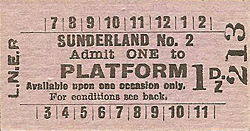 The Leamside – Bishop Auckland branch now provided an alternative route between Durham and Sunderland, far more convenient than via the Durham & Sunderland’s Shincliffe (for Durham) terminus – which was abandoned in 1893 when the D&S was re-routed to a terminus at Durham Elvet. On the day the Bishop Auckland branch was opened the branch from Belmont Junction to Durham Gilesgate closed to passengers: this had been opened by the N&DJ on 15 April 1844, providing the first station in Durham City. The Leamside – Bishop Auckland branch now provided an alternative route between Durham and Sunderland, far more convenient than via the Durham & Sunderland’s Shincliffe (for Durham) terminus – which was abandoned in 1893 when the D&S was re-routed to a terminus at Durham Elvet. On the day the Bishop Auckland branch was opened the branch from Belmont Junction to Durham Gilesgate closed to passengers: this had been opened by the N&DJ on 15 April 1844, providing the first station in Durham City.
From 1857 Leamside station enjoyed some importance as the de facto junction where trains to and from Sunderland and Durham connected with the services on London Kings Cross – Newcastle – Edinburgh main line. Fencehouses or Penshaw could equally have been awarded this status, but Leamside station, in its remote rural surroundings, was rebuilt with an island platform and bays at each end to accommodate the connecting services and allow convenient interchange by passengers. Its importance was short-lived and was suddenly removed when the new main line route between Ferryhill and Newcastle via Durham opened in 1872. Leamside station was now an extravagance, with little local population to serve; conversely the splendid Durham viaduct, originally serving only the Leamside – Bishop Auckland branch, was now a prominent feature of the main line providing a vantage point from which millions of passengers would be able to admire Durham and its cathedral.

In Sunderland the inconvenient gap between Monkwearmouth, the terminus of trains from Newcastle and South Shields on the north bank of the River Wear, and the lines from the south was closed in 1879 when in the ‘Monkwearmouth Junction’ project a bridge over the river and a tunnel under the town centre were constructed together with a new station known either as Sunderland (or Sunderland Central). From August 1879 Fawcett Street station closed and trains on the Durham line ran into the new station. The Central station also replaced the Hendon terminus, formerly used by trains to Seaham and West Hartlepool.
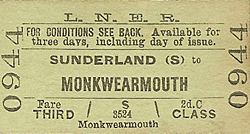 As with most lines in northern County Durham the Sunderland – Durham route carried large quantities of goods and mineral traffic, notably coal. Several collieries were directly linked to the line, and there were branches into shipyards and Deptford staiths on the Wear as well as to the Hudson, Henson and South docks on the coast. As with most lines in northern County Durham the Sunderland – Durham route carried large quantities of goods and mineral traffic, notably coal. Several collieries were directly linked to the line, and there were branches into shipyards and Deptford staiths on the Wear as well as to the Hudson, Henson and South docks on the coast.
Expecting that coal exports from Sunderland’s South Dock would increase, the North Eastern Railway and local authorities jointly funded the construction of the Queen Alexandra Bridge, to carry both rail and road traffic in the manner of High Level Bridge between Gateshead and Newcastle. The NER paid £325,000 (including railway approaches) while Sunderland Corporation contributed £146,000 and Southwick Council a further £11,000. The new bridge and associated lines would enable coal from the ex-Stanhope & Tyne line to reach South Dock, eliminating reversals at Washington and Penshaw, using instead a mineral line from Southwick Junction (between Washington and Boldon) over the new Queen Alexandra Bridge, then the Sunderland – Durham line from Diamond Hall Junction (just west of Millfield station). The bridge opened in 1909, but from the NER perspective it was a financial disaster since it apparently carried one coal train per day until the early 1920s when regular traffic ceased.
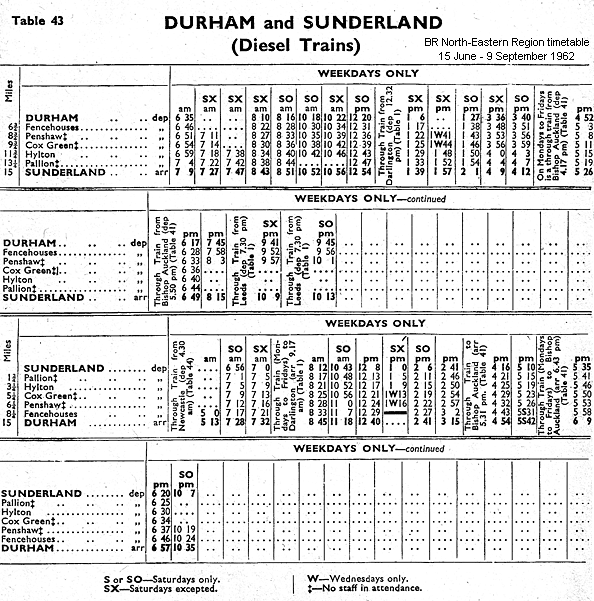
Passenger services on the Sunderland – Durham line remained frequent. However from the 1920s motor buses began to provide a more intensive service and linked the numerous mining villages and towns in north-east Durham. The ‘Old Main Line’ south of Leamside lost its passenger services in 1941. On the Sunderland – Durham route, apart from the very early loss of Frankland station, between Leamside and Durham, in 1877, casualties began with Leamside in 1953, followed by Millfield in inner Sunderland in 1955. Diesel multiple units replaced steam haulage on the route during 1957.
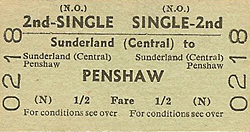 Further economies were exercised when Pallion and Penshaw were downgraded to ‘staffed halts’ and Cox Green became an ‘unstaffed halt’ on 14 August 1961. Passenger traffic censuses in summer 1962 and winter 1962-3 showed a respectable level of use on Monday-to-Friday of Hylton and Pallion stations, but limited traffic at the other stations, notably Cox Green. The Reshaping of British Railways (‘Beeching’) report of March 1963 recommended the withdrawal of passenger services between Sunderland, Durham and Bishop Auckland - as well as the services between Newcastle and Washington - and the official proposal of closure was published on 19 July 1963. Not a single objection was lodged to the Washington closure, which took place on 9 September 1963. BR must have been unprepared for the lack of resistance to this closure as a timetable for Usworth and Washington stations appeared in the winter 1963-4 North Eastern Region book. On 28 February 1964, having considered objections to the Sunderland – Durham – Bishop Auckland proposals, Ernest Marples, Minister of Transport, consented to the closure, and services were officially withdrawn on 4 May 1964. Further economies were exercised when Pallion and Penshaw were downgraded to ‘staffed halts’ and Cox Green became an ‘unstaffed halt’ on 14 August 1961. Passenger traffic censuses in summer 1962 and winter 1962-3 showed a respectable level of use on Monday-to-Friday of Hylton and Pallion stations, but limited traffic at the other stations, notably Cox Green. The Reshaping of British Railways (‘Beeching’) report of March 1963 recommended the withdrawal of passenger services between Sunderland, Durham and Bishop Auckland - as well as the services between Newcastle and Washington - and the official proposal of closure was published on 19 July 1963. Not a single objection was lodged to the Washington closure, which took place on 9 September 1963. BR must have been unprepared for the lack of resistance to this closure as a timetable for Usworth and Washington stations appeared in the winter 1963-4 North Eastern Region book. On 28 February 1964, having considered objections to the Sunderland – Durham – Bishop Auckland proposals, Ernest Marples, Minister of Transport, consented to the closure, and services were officially withdrawn on 4 May 1964.
The author was blissfully unaware of this development, and alighted from a Newcastle train at Durham on 15 May to catch the Sunderland train, only to be informed that the last one had gone! He decided to travel on to Darlington and Middleton-in-Teesdale instead – which was still open.
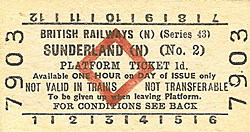 Goods services ceased between Leamside (Auckland Junction) and Durham (Newton Hall Junction) and at Finchale siding (Frankland) on 22 October 1964. The tracks into the former Fawcett Street terminus in Sunderland, which had continued as a goods facility reached from the Durham line, were severed on 3 October 1965. Goods services were retained between Penshaw and Sunderland until 21 August 1967 when they were discontinued west of Hylton Quarry sidings. In 1971 the line from Pallion to Ford paper works at Hylton was singled and ceased to be signalled when the factory closed, but Dolomite from Hylton Quarry continued to be carried until 1976 when the line was cut back to Pallion; it was officially taken out of use on 20 November 1976. The remainder of the line to Hendon, including Deptford Johnson Siding closed to goods on 27 November 1984. The section of the ‘Old Main Line’ which the Sunderland – Durham services shared between Penshaw Junction and Auckland Junction continued in goods use for some years more, but was ‘mothballed’ in 1991 and closed in 2012. Goods services ceased between Leamside (Auckland Junction) and Durham (Newton Hall Junction) and at Finchale siding (Frankland) on 22 October 1964. The tracks into the former Fawcett Street terminus in Sunderland, which had continued as a goods facility reached from the Durham line, were severed on 3 October 1965. Goods services were retained between Penshaw and Sunderland until 21 August 1967 when they were discontinued west of Hylton Quarry sidings. In 1971 the line from Pallion to Ford paper works at Hylton was singled and ceased to be signalled when the factory closed, but Dolomite from Hylton Quarry continued to be carried until 1976 when the line was cut back to Pallion; it was officially taken out of use on 20 November 1976. The remainder of the line to Hendon, including Deptford Johnson Siding closed to goods on 27 November 1984. The section of the ‘Old Main Line’ which the Sunderland – Durham services shared between Penshaw Junction and Auckland Junction continued in goods use for some years more, but was ‘mothballed’ in 1991 and closed in 2012.
Sources and bibliography:
- Biddle, Gordon Victorian stations (David & Charles 1973)
- Biddle, Gordon Britain’s historic railway buildings (Oxford University Press 2003)
- Bragg, S and Scarlett, E North Eastern lines and stations (NERA 1999)
- Clinker, C R Register of closed passenger stations and goods depots
(Avon Anglia 1978)
- Cook, R A and Hoole, K North Eastern Railway historical maps
(RCHS 2nd edition 1991)
- Fawcett, Bill A history of North Eastern Railway architecture (Three volumes)
(NERA 2001-05)
- Fawcett, Bill George Townsend Andrews of York (NERA 2011)
- Guy, Andy Steam and speed: railways of Tyne and Wear from the earliest days
(Tyne Bridge Publishing 2003)
- Hoole, Ken A regional history of the railways of Great Britain: vol 4 The North East
(David & Charles 2nd edition 1974)
- Hoole, Ken Railway stations of the North East (David & Charles 1985)
- Hurst, Geoffrey Register of closed railways 1948-1991(Milepost Publications 1992)
- Quick, Michael Railway passenger stations in Great Britain: a chronology
(RCHS 2009)
- Sinclair, Neil T Railways of Sunderland (Tyne & Wear County Council Museums 1985)
- Teasdale, John G (Ed) A history of British Railways’ North Eastern Region (NERA 2009)
- Young, Alan Lost stations of Northumberland & Durham (Silver Link 2011)
- Hansard Various (HMSO)
- North Eastern Express North Eastern Railway Society (various)
- Darsley, Roger R Darlington - Leamside - Newcastle (Middleton Press 2008)
Tickets from Michael Stewart. Bradshaw from Chris Totty. Route maps drawn by Alan Young.
To see other stations on the Old Main Line click on the station name: Felling 2nd, Felling 3rd  , Felling 1st, Pelaw 1st, Pelaw 3rd, Pelaw 4th , Felling 1st, Pelaw 1st, Pelaw 3rd, Pelaw 4th  , Pelaw 2nd, Usworth, Washington 2nd, Washington 1st, Penshaw 1st, Penshaw 2nd, Fencehouses, Rainton, Rainton Meadows (on branch), Leamside 1st, Leamside 2nd, Belmont Junction, Durham Gilesgate (on branch), Sherburn Colliery, Shincliffe & Ferryhill , Pelaw 2nd, Usworth, Washington 2nd, Washington 1st, Penshaw 1st, Penshaw 2nd, Fencehouses, Rainton, Rainton Meadows (on branch), Leamside 1st, Leamside 2nd, Belmont Junction, Durham Gilesgate (on branch), Sherburn Colliery, Shincliffe & Ferryhill
See also Coxhoe (branch frpm Ferryhill)
See also: Springwell, Brockley Whins (1st site), Brockley Whins (2nd site) 
& Boldon (route prior to 1850)
See also Sunderland and Durham (via Leamside):
Durham (still open), Frankland, Cox Green, South Hylton  , Hylton, Pallion 1st, Pallion 2nd , Hylton, Pallion 1st, Pallion 2nd  , Millfield 2nd, Millfield 1st, Millfield 3rd , Millfield 2nd, Millfield 1st, Millfield 3rd  & Sunderland Fawcett Street (on branch) & Sunderland Fawcett Street (on branch)
 Station still open as part of the Tyne & Wear metro Station still open as part of the Tyne & Wear metro |

central_old13.jpg)

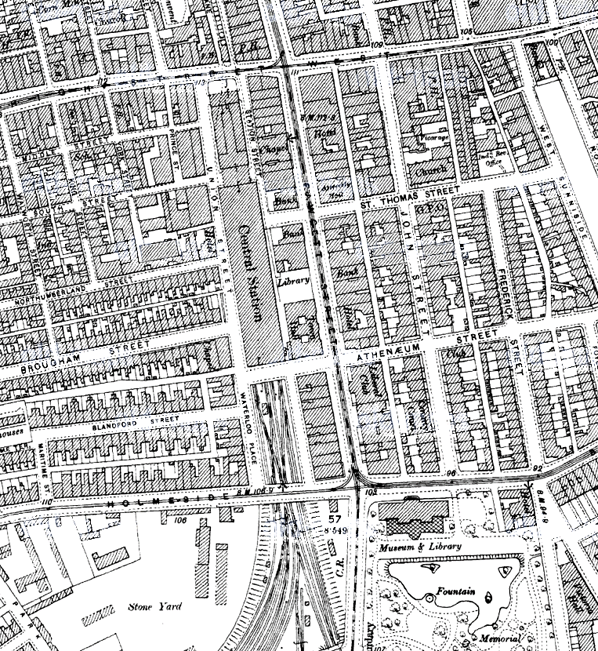
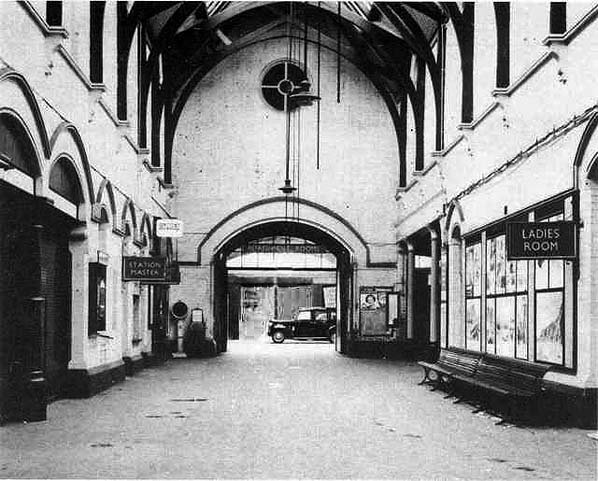
central_old21.jpg)
central_old23.jpg)
central_old3.jpg)
central_old1.jpg)
central_old19.jpg)
central_old22.jpg)
central_old11.jpg)
central_old4.jpg)
central1.jpg)
central3.jpg)
 The decision was taken by the North Eastern Railway (NER) to concentrate all of the traffic on one station conveniently placed to serve the town (now city) centre, and the contract was let in November 1874 for the expensive project. South of Monkwearmouth station the new line crossed the River Wear then ran through a cut-and-cover tunnel to the somewhat cramped Central station within a cutting. On its opening in August 1879 the Fawcett Street and Hendon termini closed. However the former terminus at Monkwearmouth was retained, an opulent classically-styled station, which in Biddle’s (1973) words, ‘became a mere suburban station, stranded like some handsome ship in a breaker’s yard’.
The decision was taken by the North Eastern Railway (NER) to concentrate all of the traffic on one station conveniently placed to serve the town (now city) centre, and the contract was let in November 1874 for the expensive project. South of Monkwearmouth station the new line crossed the River Wear then ran through a cut-and-cover tunnel to the somewhat cramped Central station within a cutting. On its opening in August 1879 the Fawcett Street and Hendon termini closed. However the former terminus at Monkwearmouth was retained, an opulent classically-styled station, which in Biddle’s (1973) words, ‘became a mere suburban station, stranded like some handsome ship in a breaker’s yard’. In Fawcett’s opinion Sunderland station was an accomplished design. However he notes that, for various reasons, the station had shortcomings. Passenger access to the platforms, booking facilities and parcels facilities proved inadequate, as did the ventilation of the platforms – when all trains were steam-hauled. The NER, as early as 1883, improved access by creating a second entrance onto a spacious bridge concourse within the trainshed, equipped with a wooden booking office and gently sloping ramps to the platforms. In 1895-7 further changes were made, described by Fawcett (2007).
In Fawcett’s opinion Sunderland station was an accomplished design. However he notes that, for various reasons, the station had shortcomings. Passenger access to the platforms, booking facilities and parcels facilities proved inadequate, as did the ventilation of the platforms – when all trains were steam-hauled. The NER, as early as 1883, improved access by creating a second entrance onto a spacious bridge concourse within the trainshed, equipped with a wooden booking office and gently sloping ramps to the platforms. In 1895-7 further changes were made, described by Fawcett (2007).
 Nexus, the operator of the Tyne and Wear Metro, announced a £7 million refurbishment platform areas at Sunderland in 2006 to be funded by the Department for Transport in a scheme in which the money ‘saved’ by reducing a subsidised local Northern Trains service in favour of Metro was converted into a lump sum for capital investment. Nexus does not own or manage the station - it is owned by Network Rail and managed by Northern - but wanted to invest as the major operator. Refurbishment began in January 2008 and was completed in July 2010. Nexus appointed Sadler Brown Architecture to develop the design, led by Arup Consulting Engineers which incorporated the work of three artists, Jason Bruges Studio, Julian Germain and Morag Morrison.
Nexus, the operator of the Tyne and Wear Metro, announced a £7 million refurbishment platform areas at Sunderland in 2006 to be funded by the Department for Transport in a scheme in which the money ‘saved’ by reducing a subsidised local Northern Trains service in favour of Metro was converted into a lump sum for capital investment. Nexus does not own or manage the station - it is owned by Network Rail and managed by Northern - but wanted to invest as the major operator. Refurbishment began in January 2008 and was completed in July 2010. Nexus appointed Sadler Brown Architecture to develop the design, led by Arup Consulting Engineers which incorporated the work of three artists, Jason Bruges Studio, Julian Germain and Morag Morrison. In an Act of 27 July 1846 the Newcastle & Darlington Junction Railway (see ‘Old Main Line’ history) was authorised to build a line from Pensher (later known as Penshaw) to join the D&S Railway at Sunderland. The line was known as the Painshaw Branch (another variation on the spelling of Penshaw). From Sunderland as far as Penshaw the line followed the River Wear valley but its route was generally some distance from the river to avoid a meander near Hylton and to serve the communities which were growing south of the river. The line opened on 20 February 1852 for goods traffic and 1 June 1853 for passengers. The terminus in Sunderland was Fawcett Street station, which opened on the same day on the southern edge of the developing commercial centre of the town.
In an Act of 27 July 1846 the Newcastle & Darlington Junction Railway (see ‘Old Main Line’ history) was authorised to build a line from Pensher (later known as Penshaw) to join the D&S Railway at Sunderland. The line was known as the Painshaw Branch (another variation on the spelling of Penshaw). From Sunderland as far as Penshaw the line followed the River Wear valley but its route was generally some distance from the river to avoid a meander near Hylton and to serve the communities which were growing south of the river. The line opened on 20 February 1852 for goods traffic and 1 June 1853 for passengers. The terminus in Sunderland was Fawcett Street station, which opened on the same day on the southern edge of the developing commercial centre of the town.  The Leamside – Bishop Auckland branch now provided an alternative route between Durham and Sunderland, far more convenient than via the Durham & Sunderland’s Shincliffe (for Durham) terminus – which was abandoned in 1893 when the D&S was re-routed to a terminus at Durham Elvet. On the day the Bishop Auckland branch was opened the branch from Belmont Junction to Durham Gilesgate closed to passengers: this had been opened by the N&DJ on 15 April 1844, providing the first station in Durham City.
The Leamside – Bishop Auckland branch now provided an alternative route between Durham and Sunderland, far more convenient than via the Durham & Sunderland’s Shincliffe (for Durham) terminus – which was abandoned in 1893 when the D&S was re-routed to a terminus at Durham Elvet. On the day the Bishop Auckland branch was opened the branch from Belmont Junction to Durham Gilesgate closed to passengers: this had been opened by the N&DJ on 15 April 1844, providing the first station in Durham City. 
 As with most lines in northern County Durham the Sunderland – Durham route carried large quantities of goods and mineral traffic, notably coal. Several collieries were directly linked to the line, and there were branches into shipyards and Deptford staiths on the Wear as well as to the Hudson, Henson and South docks on the coast.
As with most lines in northern County Durham the Sunderland – Durham route carried large quantities of goods and mineral traffic, notably coal. Several collieries were directly linked to the line, and there were branches into shipyards and Deptford staiths on the Wear as well as to the Hudson, Henson and South docks on the coast.
 Further economies were exercised when Pallion and Penshaw were downgraded to ‘staffed halts’ and Cox Green became an ‘unstaffed halt’ on 14 August 1961. Passenger traffic censuses in summer 1962 and winter 1962-3 showed a respectable level of use on Monday-to-Friday of Hylton and Pallion stations, but limited traffic at the other stations, notably Cox Green. The Reshaping of British Railways (‘Beeching’) report of March 1963 recommended the withdrawal of passenger services between Sunderland, Durham and Bishop Auckland - as well as the services between Newcastle and Washington - and the official proposal of closure was published on 19 July 1963. Not a single objection was lodged to the Washington closure, which took place on 9 September 1963. BR must have been unprepared for the lack of resistance to this closure as a timetable for Usworth and Washington stations appeared in the winter 1963-4 North Eastern Region book. On 28 February 1964, having considered objections to the Sunderland – Durham – Bishop Auckland proposals, Ernest Marples, Minister of Transport, consented to the closure, and services were officially withdrawn on 4 May 1964.
Further economies were exercised when Pallion and Penshaw were downgraded to ‘staffed halts’ and Cox Green became an ‘unstaffed halt’ on 14 August 1961. Passenger traffic censuses in summer 1962 and winter 1962-3 showed a respectable level of use on Monday-to-Friday of Hylton and Pallion stations, but limited traffic at the other stations, notably Cox Green. The Reshaping of British Railways (‘Beeching’) report of March 1963 recommended the withdrawal of passenger services between Sunderland, Durham and Bishop Auckland - as well as the services between Newcastle and Washington - and the official proposal of closure was published on 19 July 1963. Not a single objection was lodged to the Washington closure, which took place on 9 September 1963. BR must have been unprepared for the lack of resistance to this closure as a timetable for Usworth and Washington stations appeared in the winter 1963-4 North Eastern Region book. On 28 February 1964, having considered objections to the Sunderland – Durham – Bishop Auckland proposals, Ernest Marples, Minister of Transport, consented to the closure, and services were officially withdrawn on 4 May 1964.  Goods services ceased between Leamside (Auckland Junction) and Durham (Newton Hall Junction) and at Finchale siding (Frankland) on 22 October 1964. The tracks into the former Fawcett Street terminus in Sunderland, which had continued as a goods facility reached from the Durham line, were severed on 3 October 1965. Goods services were retained between Penshaw and Sunderland until 21 August 1967 when they were discontinued west of Hylton Quarry sidings. In 1971 the line from Pallion to Ford paper works at Hylton was singled and ceased to be signalled when the factory closed, but Dolomite from Hylton Quarry continued to be carried until 1976 when the line was cut back to Pallion; it was officially taken out of use on 20 November 1976. The remainder of the line to Hendon, including Deptford Johnson Siding closed to goods on 27 November 1984. The section of the ‘Old Main Line’ which the Sunderland – Durham services shared between Penshaw Junction and Auckland Junction continued in goods use for some years more, but was ‘mothballed’ in 1991 and closed in 2012.
Goods services ceased between Leamside (Auckland Junction) and Durham (Newton Hall Junction) and at Finchale siding (Frankland) on 22 October 1964. The tracks into the former Fawcett Street terminus in Sunderland, which had continued as a goods facility reached from the Durham line, were severed on 3 October 1965. Goods services were retained between Penshaw and Sunderland until 21 August 1967 when they were discontinued west of Hylton Quarry sidings. In 1971 the line from Pallion to Ford paper works at Hylton was singled and ceased to be signalled when the factory closed, but Dolomite from Hylton Quarry continued to be carried until 1976 when the line was cut back to Pallion; it was officially taken out of use on 20 November 1976. The remainder of the line to Hendon, including Deptford Johnson Siding closed to goods on 27 November 1984. The section of the ‘Old Main Line’ which the Sunderland – Durham services shared between Penshaw Junction and Auckland Junction continued in goods use for some years more, but was ‘mothballed’ in 1991 and closed in 2012. 
 Home Page
Home Page